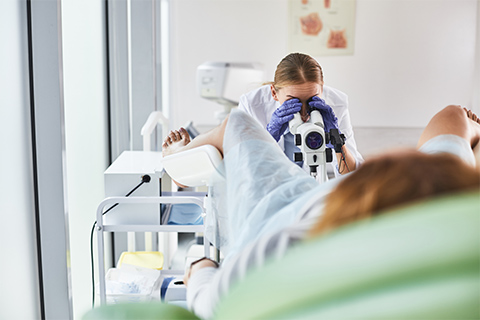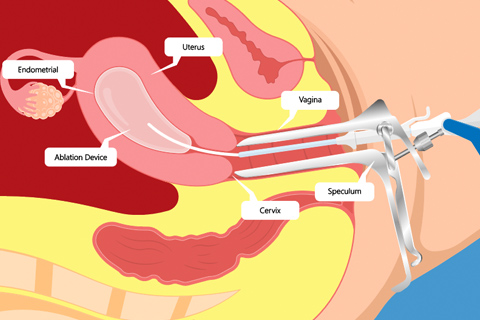Colposcopy
Colposcopy is the next test performed if a Pap test is abnormal. It is a way of looking at the cervix through a special magnifying instrument called a colposcope. It lets your doctor detect problems of the cervix that cannot be seen with the eye alone. This procedure is performed in our office.

The Pap test is known as a screening test because it helps identify people who need further evaluation. The Pap test can detect changes in the cells of the cervix at an early stage. For most women, a Pap test done each year starting at age 18, or sooner if they become sexually active, is the best screening method for finding changes in the cervix.
We now have a new method of analyzing pap smears called “Thin Prep.” A sample of cells from the cervix is placed in a bottle of liquid and sent to a pathology lab for analysis. If the Pap test results show abnormal cells called Atypical Cells of Undetermined Significance (ASCUS), a screen for high risk Human Papilloma Virus (HPV) will be performed. This virus can cause pre-malignant changes of the cervix called dysplasia. If the high risk HPV is detected, you may be advised to have further tests to diagnose the problem.
Dysplasia is a type of cervical disorder that occurs when there is a change in the cells on the surface of the cervix. Abnormal cells replace normal, non-cancerous cells. These changes are called dysplasia. Dysplasia is found in women of all ages, but it is becoming more common in young women and teenagers. Risk factors for dysplasia include history of genital warts, more than one sexual partner, sexual activity before the age of 20 and smoking. The range of dysplasia includes mild, moderate, severe and carcinoma in situ (CIS).
ClS is not a true form of cancer, but is the most likely to develop into cancer if not treated.
For the colposcopy exam, a speculum like the one used during a Pap test is placed in the vagina. The cervix will be cleansed with a mild vinegar solution that sometimes causes a slight burning sensation. A colposcope magnifies the cervix and allows the doctor to examine the cervix more closely. The colposcope itself does not touch you.
When abnormalities on the surface of the cervix are seen by colposcopy, a biopsy will be done to diagnose the problem. In this procedure, small pieces of cervical tissue are removed for study. The lining of the cervix will be scraped to identify abnormal cells that could be higher in the canal beyond view. You may have some mild cramping or feel a pinching sensation. Taking Motrin or Advil 400-600mg one hour before the procedure will help with any cramping you may experience.
If you have a cervical biopsy, a short period of healing time is necessary. You can expect some light bleeding, which is normal. A solution called Monsel’s is applied to the cervix after the colposcopy. It will cause a “coffee ground” discharge, which is normal. You will be able to shower or take a bath after the procedure. Sexual activity is fine, but you may have some irregular spotting or bleeding afterwards. Bleeding which is heavier than a menstrual period should be reported to the office.
The results of your biopsy will usually be available in 7 to 10 days. The nurse or doctor will review your results with you and discuss any follow-up treatment required.
Let's stay in touch
Our monthly newsletter keeps you up-to-date on healthy lifestyle, latest news, and our practice.




